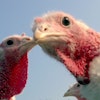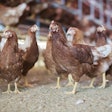
You may have never heard of the gene BTN3A3 before, but you should be glad that you have it, especially if you work in the poultry industry.
BTN3A3 is the gene that gives us protection from strains of avian influenza (AI) and is commonly expressed in our airways where it blocks AI’s replication in cells.
Its importance came to light as part of a study headed by the MRC-University of Glasgow Centre for Virus Research (CVR). The study, part of a much broader project to look at AI’s pandemic potential, has looked at hundreds of genes normally expressed by human cells during a viral infection with either human seasonal viruses or AI viruses.
BTN3A3 is not, however, always successful in blocking AI replication, and some strains can evade it. It did not work, for example, against the virus strain - now thought to have been AI strain - that caused the 1918 Spanish flu pandemic which resulted in 25 million deaths.
So why are some strains able to evade this useful gene?
Mutant movements and how to stop them
To answer this, the Glasgow team looked in more detail at the N7N9, virus strain which, since 2013, has infected more than 1,500 individuals, with a 40% case mortality rate. They found that N7N9, and some others, have a genetic mutation that allows them to escape the blocking effects of BTN3A3.
What the researchers also found while studying the evolution of AI virus strains was that where there had been spill-over events into humans, there was an increase in the number of BTN3A3-resistant virus strains circulating.
While BTN3A3 may offer protection against most AI strains, it is not going to protect us against all of them, but knowing this does allow the development of new strategies to protect human health.
Identifying BTN3A3 resistant variants when they first emerge in birds would allow greater measures to be taken to prevent human infection. Control measures against emerging AI viruses could be tailored specially against those that are resistant, in addition to other genetic traits known to be important for zoonotic transmission.
Thankfully, BTN3A3 is going to protect us against most AI virus strains and, where it can’t, at least we now have the knowledge to step in where the gene can’t help out.



















